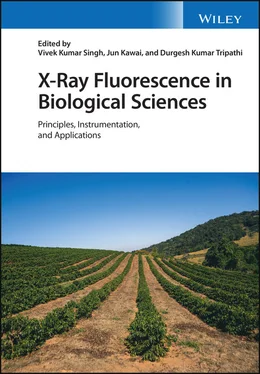6.3.6 Precision and Accuracy of the Result
EDXRF being a comparison method of elemental analysis requires the construction of a calibration curve to validate results. This curve is obtained by irradiating a commercially available standard reference material (SRM) (prepared in the same manner as the real sample) of a similar matrix. The basic concept operative here is that both the real sample and SRM should produce identical sensitivity, thus nullifying the matrix effect. In this study, commercially available standard reference material Spinach (NIST 1570a) was used to construct the calibration curve [15], taking into account that plants and blood have similar biological matrices. The constructed calibration curve has been validated by analyzing CRM (certified reference material) Orchard Leaf (NIST1571) and the obtained values were found to be in good agreement with the certified values. The relative error and coefficient of variation in percentage were in the acceptable range (<10%) as shown in Table 6.2 .
Analysis of body tissue (urine, blood, plasma, nail, or hair) for the determination of its composition has become the most powerful and ubiquitous tool for disease detection and control in recent years. If there any case of suspected exposure to different toxic element (Pb, Cd, and As), measurement of those element by using EDXRF is an excellent technique. Moreover, the presence of even some essential elements in more than the required quantities in any body tissue, like iron in urine, or manganese in blood, that can cause organ malfunction or pathogen‐initiated disease can also be detected by EDXRF. In addition, it may be said that XRF analysis using EDXRF spectrometers is a unique technique for the identification and quantification of elements in any substance, including body tissue. It is a fast, accurate technique for the determination of elements in even very small quantities of samples. it is notable that, for the rapid, nondestructive clinical analysis of trace element recently XOS, the Alzheimer's Center of Albany Medical Center, Albany, NY, USA in colaboration with the Wadsworth Center (New York State Department of Health, Albany, NY, USA) started to measure trace elements of interest; potential diagnosis and treatment of neurodegenerative diseases using an NIH‐supported study (NIH 2R44RR021797‐02) toward development of an HD XRF‐based analyzer [18].
Table 6.2 Precision and accuracy of the method.
| Elements |
Elemental concentration in Orchard leaf/NIST 1571 (mg/kg) |
Mean |
SD |
Certified value Orchard leaf/NIST 1571 |
RE (%) |
CV (%) |
| Exp‐1 |
Exp‐2 |
| K |
13 340 |
13 410 |
13 375 |
49.50 |
14 700 |
9.01 |
0.37 |
| Ca |
19 670 |
19 779 |
19 725 |
77.07 |
20 900 |
5.62 |
0.39 |
| Mn |
93.51 |
94.21 |
93.86 |
0.49 |
91 |
−3.14 |
0.53 |
| Fe |
270 |
298 |
284 |
19.80 |
300 |
5.33 |
6.97 |
| Cu |
11.97 |
10.49 |
11.23 |
1.05 |
12 |
6.42 |
9.32 |
| Zn |
26.99 |
24.97 |
25.98 |
1.43 |
25 |
−3.92 |
5.50 |
| As |
9.45 |
8.97 |
9.21 |
0.34 |
10 |
7.90 |
3.69 |
| Rb |
11.25 |
11.43 |
11.34 |
0.13 |
12 |
5.50 |
1.12 |
| Sr |
43.42 |
40.21 |
41.82 |
2.27 |
37 |
−13.01 |
5.43 |
| Pb |
46.98 |
48.60 |
47.79 |
1.15 |
45 |
−6.20 |
2.40 |
However, the present study ascertained,the precision and the accuracy of the obtained results were excellent ( Tables 6.1and 6.2). Total cost of analysis was also low as no chemicals were used to prepare the samples for analysis and makes it more affordable by the patients/customers. This method is very simple and handling the system is very easy. EDXRF has been demonstrated to be a very potential technique with high precision and accuracy with good sensitivity for the determination of As in hair tissue and Pb in whole blood samples at the clinical point of care. So, EDXRF is worthy of use in clinical diagnosis, particularly for the above mentioned cases.
1 1 Ahmad, S.A. and Khan, M.H. (2015). Ground water arsenic contamination and its health effects in Bangladesh. In: Handbook of Arsenic Toxicology (ed. S.J.S. Flora), 51–72. New York, NY: Academic Press Publishers.
2 2 Caussy, D. (2006). A field guide:detection, management and surveillance of Arsenicosis in South‐East Asia region. WHO, regional office for South‐East Asia. https://apps.who.int/iris/handle/10665/204725.
3 3 Farmer, J.G. and Johnson, L.R. (1990). Assessment of occupational exposure to inorganic arsenic based on urinary concentrations and speciation of arsenic. Br. J. Ind. Med. 42: 342–348.
4 4 Arsenic contamination of ground water in Bangladesh [briefing paper] (2000). Ministry of Health and Family Welfare. Bangladesh.
5 5 Ryabukhin, Y.S. (1976). Activation Analysis of Hair as an Indicator of Contamination of Man by Environmental Trace Element Pollutants, 135. International Atomic Energy Agency (IAEA); IAEA‐RL—50.
6 6 Jolly, Y.N., Islam, A., and Akber, S. (2013). Transfer of metal from soil to vegetables and possible health risk assessment. Spriger Plus 2: 385.
7 7 Hossain, M.S., Ahmed, M.K., Liyana, E., Hossain, M.S., Jolly, Y.N., Kabir, M.J., Akter, S., and Rahman, M.S. (2021). a case study on metal contamination in water and sediment near a coal thermal power plant on the eastern coast of Bangladesh. Environments 8:108. https://doi:org/10.3390/environments8100108.
8 8 Ali, M. and Tarafder, S.A. (2003). Arsenic in drinking water and scalp hair by EDXRF:a major recent health hazard in Bangladesh. J. Radioanal. Nucl. Chem. 256 (2): 297–305.
9 9 Al‐Farsi, Y.M., Waly, M.I., Al‐Sharbati, M.M. et al. (2013). Levels of heavy metals and essential minerals in hair samples of children with autism in Oman: a case‐control study. Biol. Trace Elem. Res. 151 (2): 181–186.
10 10 Alabdali, A., Al‐Ayadhi, L., and El‐Ansary, A. (2014). A key role for an impaired detoxification mechanism in the etiology and severity of autism spectrum disorders. Behav. Brain Funct. 10 (14): 1–11.
11 11 Johnson, C.P. and Myers, S.M. (2007). Identification and evaluation of children with autism spectrum disorders. Pediatrics 120 (5): 1183–1215.
12 12 Rahbar, M.H., Samms‐Vaughan, M., Dickerson, A.S. et al. (2015). Blood lead concentrations in Jamaican children with and without autism spectrum disorder. Int. J. Environ. Res. Public Health 12: 83–105.
13 13 Adams, J.B., Audhya, T., McDonough‐Means, S. et al. (2012). Toxicological status of children with autism vs. neurotypical children and the association with autism severity. Biol. Trace Elem. Res. 151 (2): 171–180.
14 14 Smith, D., Hernadez‐Avila, M., Maria Tellez‐Rojo, M. et al. (2002). The relationship between lead in plasma and whole blood in women. Environ. Health Prospect. 110 (3): 263–268.
15 15 Ali, M.S., Begum, B.A., Akhter, S. et al. (2018). Evaluation of blood lead level as a risk factor in children with autism spectrum disorder: a case control study. J. Blood Disord. Transfus 10 (1) https://doi.org/10.4172/2155‐9864.1000415.
16 16 Jolly, Y.N., Rakib, M.R.J., Islam, M.S., Akter, S., Idris, A.M. and Phoungthong, K. (2021). Potential toxic elements in sediment and fishes of an important fish breeding river in Bangladesh:a preliminary study for ecological and health risk. Toxin Reviews. doi:10.1080/15569543.2021.1965624.
Читать дальше











